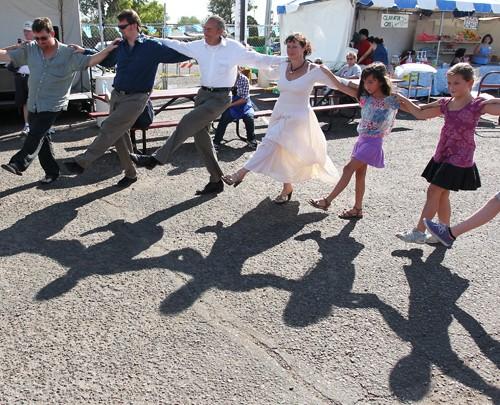October is marks the beginning of a busy time for volunteers, coordinators and attendees with dozens of exciting excursions celebrating culture and customs in the form of carnivals and festivals throughout Cochise and Pima counties. This weekend, the fun began at the 35th Annual Greek Festival at St. Demetrios Hellenic Center. This is an entirely volunteer-initiated festival; all the food handlers, vendors and lecturers were either members of the church or volunteers who wanted to help. Their hard work is a symbol of hospitality, one of the most important aspects of many cultures in the world.— Though, nobody does it quite like the Greeks.
This unassuming building, tucked between 1st and Campbell avenues on Fort Lowell Road, was turned into a spectacular fair boasting dozens of activities. Tents lined the parking lot, lectures and guided tours through the church were being conducted, but the real experience was taking place inside the community room. Books and delicious pastries were sold, and there was a market where one could buy rice pilaf, kalamata olives, big blocks of feta cheese, dolmathes (meat stuffed grape vine leaves) and various Greek spices. Outside there was music, traditional dancing, scarves and jewelry in the form nazars that ward off the evil eye, which traditionally is believed to be an agent of bad luck, injury and illness. “”There is a fair amount of mysticism in Greek Orthodoxy,”” said Eleni Sakellar, a long-time volunteer and member of the church.
The line for food was as much of a spectacle as the festival itself. Though a little pricy, as is the case at most carnivals, the food was delicious, as is not usually the case in most carnivals. Giant pieces of spanakopita, generous portions of gyros and visually enticing morsels of baklava kept people waiting in line; it was all well worth the wait. Greek beer, Keo, was being sold as well. Up on stage, a group of musicians and dancers demonstrated traditional, and sometimes intricate dances.
The most commonly known form of dance is the open circle, in which arms are put around shoulders and the circle moves counterclockwise. However, the Kalamatiano was most popular on Sunday. It is a type of Syrto, meaning dragging or pulling, and is an ancient folkdance known for its handkerchiefs (sometimes made of the Kalamata silk) that are used to separate the dancers’ hands. Shouts of “”Opa!”” were heard all around as well as Greek chatter.
There is a surprisingly strong Greek presence in Tucson; over 450 families attend church regularly at the Hellenic Center. The festival began as a “”small scale church bazaar (held) in order to make some extra money for the church,”” said Father Earl Cantos. Over the last 35 years, it has steadily grown into large cultural exchange that gives Tucsonans the opportunity to get a taste of Greece. It is a demonstration of culture and food and tradition, as well as an opportunity to share the faith of Orthodoxy.
Cantos explained that Greek Orthodoxy sees “”life as interaction with the other world.”” and that your actions and relationships influence your spiritual journey; “”your love of someone is loving God, your abuse of someone is abusing God”” said Father Cantos.
Not only does this festival open to the public different avenues to enjoy the culture of Greece, through informational pamphlets in which you can learn Greek phrases (“”Ya’Sou!”” means “”Hello”” and “”S’Agapo”” means “”I love you””). Pamplets also gave information on Greek dances, food and trinkets, giving one the opportunity to learn a little bit about Orthodoxy and the importance of faith. If you missed out this year, be sure to make it next year; it is an exciting and eye-opening experience that is eager to share with you the kefi (spirit) of culture.









